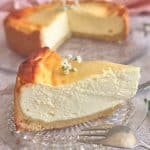Traditional German Cheesecake (Käsekuchen)
This traditional Germancheesecake can be baked with out without quark
Servings 8 people
Calories 516kcal
Equipment
- hand or stand mixer
- 26 cm / 10 inch round cake pan
Ingredients
For the base
- 250 g flour 8.8 oz (Germany type 405, UK plain four, USA pastry flour)
- 125 g butter 4.4 oz - at room temperature
- 100 g sugar 3.5 oz
- 1 egg medium size, at room temperature
- 1 teaspoon baking powder
For the filling
- 1 kg Quark 35 oz - OR 500 g / 17.6 oz cream cheese and 500 g / 17.6 oz Greek yoghurt (10% fat)
- 200 g granulated sugar 7 oz
- 200 g whipping cream 7 oz
- 5 medium eggs at room temperature
- 40 g corn flour 1. 4 oz (alternatively you can use shop-bought or homemade vanilla pudding powder)
- 2 teaspoon vanilla sugar (see how to make homemade vanilla sugar or alternatively use 2 teaspoon vanilla extract)
- 1 teaspoon grated lemon peel
Instructions
To make the base
- Preheat the oven to 180°C/ 356°F -top- bottom heat and line a 26 cm, 10 inches round cake form with parchment. Grease the sides with butter and dust with flour, this will make it easier to remove the cake from the form later.
- Using a hand or stand mixer, mix the butter and sugar until creamy. Add the egg, flour and baking powder and mix until completely combined.
- Transfer the dough to a floured work surface or use a non-stick silicone mat. The shortcrust pastry dough should come together easily and should not feel overly sticky. Divide the dough into two. Using floured hands roll one of the dough parts into a roll and lay it around the edge of the baking form. (see pictures in post to how it is done)
- With your fingers – press the edges up to create the crust of the cake (see pictures). The edges should be around 5 cm high.
- Roll out the remaining part of the dough and press it into the bottom of the pan.
To make the filling
- Using a hand mixer or a stand mixer fitted with a whisk attachment, whip the whipping cream into stiff peaks on medium-high speed, this should take about 4-5 minutes. Set aside.
- Using a hand mixer or a stand mixer fitted with a whisk or paddle attachment beat the quark (alternatively cream cheese and Greek Yoghurt), eggs, vanilla sugar, cornflour, eggs and lemon peel and granulated sugar together on medium speed until perfectly smooth and creamy. Scrap down the sides and up the bottom of the bowl with a rubber spatula as needed. - Now gently fold in the stiff cream into the mixture.
- Spread the filling into the cake form.
- Place the cake into the oven and bake for 30 minutes. After 30 minutes remove the cake from the oven. With a sharp knife make a round incision about 1 cm from the edge. This will prevent your cake from cracking in the middle. (see pictures in post)
- Place back in the oven and bake for a further 30 minutes. (Total baking time approx. 1 hour)
- Baking time will vary according to your oven. After 1 hour check if the cake is done by pricking a skewer in the middle. If it comes out clean it is done. If not, place it back in the oven and check again every 5 minutes. (You will see that the cake has risen around the edges of our incision. Do not worry it will deflate back down and the cut won't be as visible).
- In order to prevent your cake from splitting, you can cool the cake on the oven rack carefully pulled out and the door left open.
Notes
Please check the step by step images on the main post.
Nutrition
Calories: 516kcal | Carbohydrates: 74g | Protein: 25g | Fat: 13g | Saturated Fat: 7g | Polyunsaturated Fat: 1g | Monounsaturated Fat: 4g | Trans Fat: 1g | Cholesterol: 159mg | Sodium: 177mg | Potassium: 120mg | Fiber: 1g | Sugar: 45g | Vitamin A: 571IU | Vitamin C: 1mg | Calcium: 87mg | Iron: 2mg
